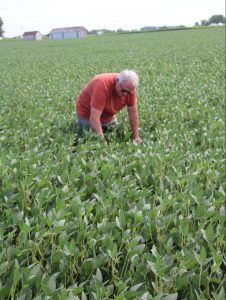Taking care of the land and crops
By Dusty Sonnenberg, CCA, Ohio Field Leader: a project of the Ohio Soybean Council and soybean checkoff.
Stewardship of the land is an important job that many farmers take great pride in. The desire to leave a farm a little better for the next generation is a noble pursuit. Brad Haas has been working to improve the ground he farms every year. “There is always something you can improve,” said Haas, who farms with his son Kennen and nephew Kyle. “You can always work to improve the drainage. A field can always use tile, or surface drainage to move water. You can always work on improving the soil fertility or work to reduce compaction.” These are the concepts Brad has been passing on to the next generation on his Wood County Farm, and the improvements to the soil are proof.
Haas raises Field Corn, Pop Corn, Soybeans, Wheat, and Green Beans in Wood and Henry Counties. “When I started farming, Dad let me take over a couple of tough farms, and with time I was able to turn them around,” said Haas. “One key is being patient and not getting out on them too early when it is just a little too wet. Another key is having good drainage.” Haas has systematically been ditching is farms to improve the drainage, and recently also purchased a slinger rotary ditcher to cut surface ditches. “Kennen has it hooked up so he can use the GPS for depth control, along with guidance and mapping,” said Haas.
In 2019 Wood County Ohio had the largest number of prevent plant acres in the state. “Over half of the county did not get planted last year,” said Haas. “We had several farms we had to let go and take the prevent plant because it was too wet, and got too late in the season.” Haas has been working to get back to the cropping rotation he had prior to 2019. “Every farm has a little different rotation based on if it is a lighter sandy soil, or a heavier clay soil. On the lighter sands to the north, we will grow multiple years of corn back to corn, followed by soybeans. On the heavier clay soils to the south, we will incorporate wheat in the rotation,” said Haas.

“This particular field of beans was also soybeans in 2019, and wheat before that. It has been in a 2-year beans, one-year wheat rotation. It just depends on the farm.”
Haas also knows you need to be a good steward to the crop. “Take care of the soil and the crops, and they will take care of you.” Haas will regularly spray both fungicide and insecticide as needed in season. This year he sprayed about 1/3 of his corn acres with both fungicide and insecticide using a helicopter. “We intensively manage our crops and more often than not, the final yields represent that,” said Haas. “We have had years when we don’t always see the results, and years when it has more than paid. I tell my son, at the end of the day, it needs to make money.”
2020 has been a complete reversal from 2019. “We started planting corn on April 27th, and soybeans on May 1st. This year, we got off to a really good start. The ground had good soil moisture, and the crops were planted timely and had uniform emergence,” said Haas. “We had a heavy rain about a week after we finished planting on May 13th. On the 19th, we got 2 ½ inches in one shot. After that we only received a total of 1.1 inches until the first of August. We caught about .8 inch on Saturday, August 1st, and then another .2 inch this past Monday. For two months, this crop has been surviving on less than an inch or rain,” said Haas. That is why it is important to take care of the soil and the crop.
For the 2020 Ohio’s Country Journal and Ohio Ag Net Virtual Crop Tour, a soybean field in western Wood county was one of the submissions evaluated. It was Hoytville clay soil and well drained. The soybean field was beans back to beans. It was a 2.4 maturity bean. The crop was very uniform with a canopy height of 31” The beans had nodes every 2 inches, with most nodes having three pods, and some having four. The majority of pods had three beans, however most plants had at least one or two four-bean pods. The field was sprayed with both a fungicide and insecticide about a week prior to our evaluation. It was clean with not disease present, and very little insect feeding observed. It was also an Xtend bean that had been sprayed with Xtendimax at the end of June, and there was now weed pressure currently. Overall, it appears to be an excellent bean field.
Weather is going to be a key factor. A few timely rains will fill out the bean pods and could bring another yield similar to 2019 when it went over 60 bushels per acre.